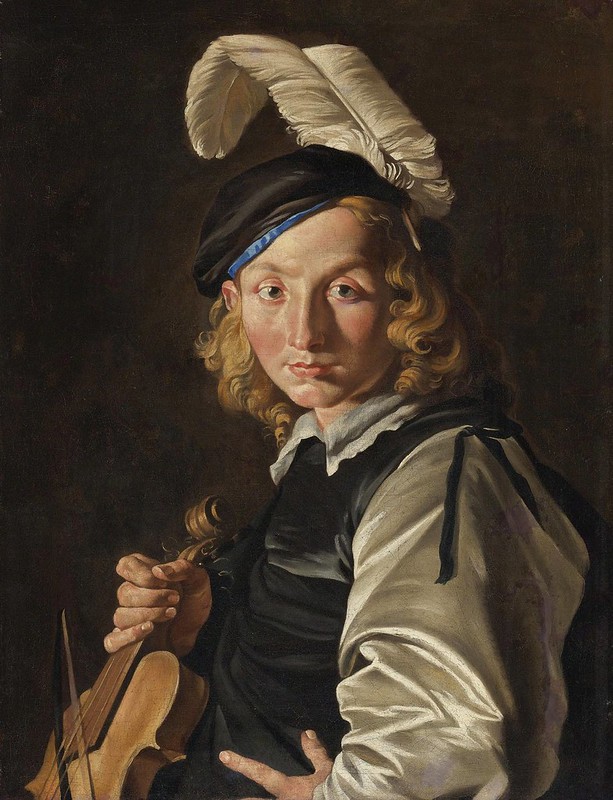Parlem de Pintura...
Mathias Stomer (Amersfoort, c.1600 - Sicília, c.1652) va ser un pintor holandès d'estil tenebrista, englobat en el cercle de pintors del caravaggisme. El seu nom es va escriure de formes diverses, en algunes fonts va figurar com Matthias Stomer, i en altres com Mathias Stom. Es coneixen poques dades segures de la seva vida. Es creu que es va iniciar en la pintura amb Abraham Bloemaert a Utrecht. Després va viatjar a Roma, on entre els anys 1620 i 1623 va ser deixeble del pintor caravaggista Gerrit van Honthorst. D'aquí va passar a Nàpols, i el 1640 es va instal·lar a Sicília. Stomer s'explica entre els caravaggistes nòrdics més importants, juntament amb Honthorst. Es diferencia d'aquest pel seu colorit més càlid i limitat, en general, en gammes terroses, i pel predomini dels temes religiosos en la seva producció, davant de les escenes de gènere o quotidianes d'Honthorst i altres tenebristes. Entre les seves obres, cal destacar Samsó i Dalila (Palau Barberini de Roma), L'adoració dels pastors (Viena, Museu Liechtenstein) i La incredulitat de Sant Tomàs (Madrid, Museu del Prado), que algunes fonts segueixen atribuint per error a Gerrit van Honthorst. Hi ha altres obres seves al Museu Nacional d'Art de Catalunya, al Museu Thyssen-Bornemisza de Madrid (El sopar d'Emaús), al Museu Sant Pius V de València (Sant Sebastià atès per Irene i la seva criada), a la Galeria Nacional d'Irlanda (Dublín) i al Museu de la Universitat Bob Jones de Greenville (Carolina del Sud, EUA). Es creu que va morir a l'entorn del 1652.
Font: En català: Matthias Stomer (c.1600-c.1652) - En castellano: Matthias Stomer (c.1600-c.1652) - In english: Matthias Stomer (c.1600-c.1652) - Altres: Matthias Stomer (c.1600-c.1652)
Parlem de Música...
Emanuel Siprutini (c.1730 - c.1790) va ser un violoncel·lista i compositor holandès. Fill d'un comerciant jueu, es creu que ben aviat va viatjar a Itàlia i Espanya. Es té constància, també, que Leopold Mozart va coincidir amb Siprutini a Londres el 1764, un any que, pel que sembla, estava a la ciutat anglesa com a violoncel·lista virtuós. Com a compositor va escriure diverses obres de cambra per a violoncel, entre elles els Six Solos for a Violoncello (c.1775) que va dedicar a Moses Franks (1719-89), el líder de la comunitat jueva a Anglaterra d'aquell temps. Anys més tard va viatjar a Bèlgica on es va dedicar a la venda de vi. Es desconeix el lloc i l'any de la seva mort.
Font: En català: No disponible - En castellano: No disponible - In english: Emanuel Siprutini (c.1730-c.1790) - Altres: No disponible
Parlem en veu pròpia o en veu d'altri...
But the Siprutini sonatas are not for the amateur or those who balk at technical challenges; these are enormously difficult works that far outstrip the Geminiani sonatas in difficulty. As Balázs Máté, the soloist, points out in the annotations, “through the use of the so-called thumb position, the range of the instrument was extended more and more towards the giddy heights of two and three-line registers, and almost all elements found in virtuoso violin technique (double-stops, harmonics, barriolage, etc.) appeared in cello music.” The first edition of these sonatas, dedicated to one Moses Frank, appeared sometime between 1775 and 1780. We know as little about the dedicatee as we do the composer, but from the flowery text on the printed edition, we can safely assume that Mr. Frank was a music-loving citizen of the English capital and that he also had some part in advancing Siprutini’s career. Each of these works follows the standard three-movement form that would mature into the Classical sonata with a fully developed A-B-A first movement, chock full of virtuoso-writing. The slow movements resemble songs in both construction and content, ranging in emotion from graceful and refined expressiveness to heartfelt sorrow. As for the finales, there is also much variety, from minuet and gigue to the traditional English country-dance.
The Fifth Sonata is particularly interesting, as its opening movement conjures an atmosphere of gaiety, followed by a sorrowful slow movement. With this lingering in the ear, the rollicking country-dance finale takes us completely by surprise. As one can glean from the heading, there is much variety in the choice of continuo instruments, but perhaps a bit too much. I suppose that I’m an old fuddy-duddy, but I find the practice of swapping instruments (harpsichord to organ, cello to double bass) within movements of the same sonata disconcerting, even though this may have been done. These are indeed impressive performances of fiendishly difficult works, played with confidence, astounding technique, and exceptional tonal purity. Máté seems to have successfully captured not only the appropriate style but also the essence of Siprutini’s music. In Máté’s hands, the cello—unmentioned by either name or year of construction in the annotations—sings sweetly, growls in mock-anger, and dances about with enviable ease. There is also some exceptionally fine and creative continuo realization provided by organist and harpsichordist Miklós Spányi. When I told a friend of mine who is a professional cellist about this disc, he ordered it, even though he was a bit leery. Several weeks later he wrote me, saying, “Where has this music been for all these years? This is great stuff! Now if I can only locate the music!” Enough said?
Michael Carter (source/font: aquí)
Gaudiu i compartiu!
Informació addicional...
PRESTOCLASSICAL: SIPRUTINI, E. - Six Solos for Violoncello with a Thorough Bass, Op. 7
IMSLP: No disponible
CPDL: No disponible


Un administrador del blog ha eliminat aquest comentari.
ResponElimina